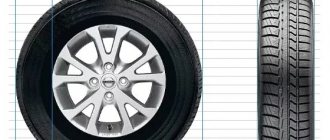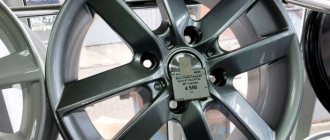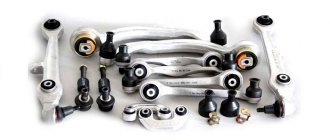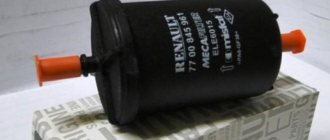Good afternoon, dear reader.
Every year, as cold weather approaches, drivers begin to wonder when to put on winter tires. Currently, the answer to this question is partially regulated by a regulatory legal document.
The relevant law is Technical Regulations of the Customs Union TR CU 018/2011 On the safety of wheeled vehicles.
In this article we will talk about the legally established deadlines for changing summer tires to winter ones. In addition, a fine for improper use of tires will be considered.
Let's get started.
When is it necessary to replace tires?
As you know, the climate in Russia is variable, and winter can be either early or late. What to rely on in such a situation?
- You must use an outdoor thermometer. If it shows a temperature of +7°C±5°C, this should prompt the driver that it’s time to change the car’s shoes.
- With the onset of cold weather, the air gradually cools down, because of this the tires become stiffer and, accordingly, have poor adhesion to the surface.
Driving on an icy road on summer tires is life-threatening. Such behavior on the road can provoke an emergency situation, because at any moment the car can become uncontrollable. Therefore, it is not worth the risk.
It is important to adhere to the information specified in regulatory documents, and you should not ignore instructions from tire manufacturers. Then the risk of accidents on the road will significantly decrease.
Traffic regulations on the condition of tires and wheels
In 2022, the Traffic Rules with Appendix No. 1 “List of faults and conditions under which the operation of vehicles is prohibited” are relevant. The fifth paragraph regulates the permissible depth of the tread pattern and deformations in which the use of transport entails the risk of an accident for all road users. This clause stipulates the application of penalties in the amount of 500 rubles. The motorist can also simply be warned not to use the car in poor condition.
Tread depth
Measuring the tread depth is required if there is no indicator. If it is provided for by the tire design, then wear is determined by it. Tread depth specified in traffic regulations:
- for motorcycles, mopeds – 0.8 mm;
- for passenger cars and trucks with a carrying capacity of less than 3.5 tons - 1.6 mm;
- for trucks (from 3.5 t) – 1 mm;
- for buses and fixed-route transport with more than 8 passenger seats - 2 mm.
These indicators are established for road surfaces without snow and ice. In conditions of ice and snow cover, the tread depth should be at least 4 mm. If the indicator is 3.5 mm or less, then a penalty is provided - a fine of 500 rubles.
When is it legal to change tires?
The technical regulations contain detailed information about when to change winter tires on your car, and at what time of year which tires to use.
It is important that winter tires are used on all four wheels. And here there is no question about which tires to choose: studded or not. The bottom line is that in winter you definitely need to drive only on non-winter tires.
Nowadays, the market offers tires suitable for all seasons. By law, its use is permitted if it contains special characters, such as: “M+S”, “M&S” or “MS”. If these inscriptions are not on the rubber, then it is not suitable for use.
The order of using tires by season
The Regulation “On the Safety of Wheeled Vehicles” clearly explains in which season the use of certain types of tires is permitted. The main data is presented in the table.
| Winter tires with studs | Winter tires without studs | Summer tires | All-season with M+S marking | All-season without M+S marking | |
| Winter | + | + | – | + | – |
| Summer | – | + | + | + | + |
| Off-season | + | + | + | + | + |
Throughout the year, the use of studless winter tires and all-season tires marked M+S is allowed. Other types of tires have limitations.
Fines
Any driver who breaks the law will face punishment from the traffic police. Driving on winter tires that do not comply with weather conditions is subject to a fine.
- A fine may also be imposed for using worn-out and low-quality tires; the amount will be 500 rubles.
- In all other cases, the driver can get away with a verbal remark.
It should be noted that November 15 is the recommended day for replacing summer tires with winter tires in central Russia.
But you shouldn’t wait for this particular day at all; you need to remember the predominance of a heterogeneous and variable climate on the territory of the Russian Federation, and, focusing on the weather outside the window, replace the tires with winter ones.
What happens if you don't change your summer tires?
The technical regulations of the Customs Union have already prescribed the procedure for using seasonal tires since January 1, 2015. Legislation introduces mandatory use of winter tires from December to February inclusive.
On the other hand, each region can adjust the time frame independently. This directly depends on the weather conditions of a particular year. Until now, there are no administrative penalties for violating the established rules.
At the government level, officials developed bills providing for a fine of 2,000-10,000 rubles for using tires out of season. Despite this, no changes were made to the Code of Administrative Offenses of the Russian Federation.
Only with a very strong desire, a traffic police inspector can issue a fine in the category of other violations. Its size will be 500 rubles.
On the other hand, the use of treads with spikes is limited by law. They can be ridden until a maximum of June 1, subject to cold weather. As for summer tires, you can legally drive them only until December 1st. For violation of such requirements, a fine of 500 rubles is provided (Part 1 of Article 12.5 of the Administrative Code). Certain regions of the Russian Federation with a harsher climate have their own limitations.
Car tires: which ones to choose
Experienced drivers recommend the need to have three sets of tires at once: winter, summer and studded.
In the cold season, the air temperature usually ranges from -3°C to +5°C, in this case it is necessary to use winter tires without studs, and when the cold weather comes sharply, it is worth changing to winter studded tires.
- But this method is quite expensive, so it is not accessible to everyone. In this case, you need to choose studded tires or tires without studs.
- Don’t forget that tires without studs are suitable for dry and wet roads, while tires with studs are suitable for icy roads and those covered with a layer of snow.
- Studded tires on any asphalt have a braking distance that is 7% longer than non-studded tires.
Such tires are quite expensive, but over time their price should begin to fall, and then they will become available to absolutely any car enthusiast.
Where is the tire replacement period indicated?
The period of operation of studded tires and winter friction rubber is specified in the Technical Regulations, which came into force in Russia at the beginning of 2015. The international regulations, to which member countries of the Customs Union have joined, indicate that tires with studs cannot be used in the summer. Winter tires must be installed for the winter period (from December 1 to February 28 (29), and the use of friction tires (in common parlance, “Velcro”) is allowed at any time of the year.
Traffic police officers have no right to punish for tires that do not correspond to the season, since Russian legislation does not provide for sanctions for operating a car with summer tires in winter and vice versa. However, there are rules according to which a driver can be fined for worn out tread, deformation of tires and wheels.
Differences between winter tires and all-season tires
The use of all-season tires helps to save money, but given the nature of the Russian climate, its use is not always effective.
For example, the range set by drivers is from -5 to +20°C.
Therefore, by choosing this type of tire, the driver puts his life in danger.
What tires are best for winter?
Nowadays, several types of winter tires with different characteristics are used. There are a huge number of adherents of various modifications of tires designed for the winter season. First of all, you should understand what the essence of the debate is and start with the types of tires, their advantages and disadvantages.
Studded rubber or Velcro
Velcro. Tires with a similar tread are suitable for urban conditions where there is no heavy snowfall or serious snow drift. Moreover, these tires are recommended for comfortable driving conditions. They are distinguished by good grip on loose surfaces, moderate acoustic effects and good softness. Among the disadvantages is poor cross-country ability in deep snow and ice crusts.
Studded. The modification can be used for regions where winters are really snowy and cold, and there is also an abundance of precipitation, variable temperatures and poorly cleaned roads. Such tires are not afraid of deep debris, ice and compacted ruts. The disadvantages include high noise, heavy weight and the possibility of losing some of the studs on bare asphalt.
Wide or narrow tires
There is also a lot of debate about what width to install tires for the winter. The differences are only in the shape of the tread and the shape of the contact patch, based on which the characteristics of the wheels differ.
Narrow tires are mainly designed for winter and are often used on slippery and wet roads. Thanks to the elongated contact patch with long longitudinal edges, such wheels grip the road much better and perfectly resist lateral overloads. An extended contact patch better combats them in sharp turns and keeps the car from drifting and skidding. In bad rainy or snowy weather, the narrow wheels seem to bite into the asphalt and keep the car on a straight path.
Wide tires are best used in dry summer weather. They are worse for winter. These tires are suitable for aggressive active driving at high speeds. Wide tires combat wheel slip during takeoff. They brake better, since the front edge of the tread has a larger area. That is, the controllability of the car depends on the width of the tire. Its sidewalls are made firm and low, which is why the car resists roll under lateral overloads. Moreover, wide wheels are suitable for driving that involves frequent acceleration and braking cycles.
Thus, which tire is better should be determined by each motorist personally. Both versions have pros and cons, and the type of terrain and driving style will tell you where the greatest benefit is.
Winter tires: When to use
Any driver must remember five basic rules for using tires:
- You cannot swap wheels, that is, rearrange, for example, the left one in place of the right one.
- If you use non-studded tires, then you should not exceed the speed above 70 km/h, and it is also not recommended to increase the speed for the first 1000 km of the road; you must first “break in” the tire.
- In winter, when the temperature is not stable, you need to monitor the tire pressure. You can add it little by little, but not exceed 0.1-0.2 atm.
- Winter tires must be placed on both axles. There is no need to take seriously the opinion that installation on one axle does not increase the safety of the car when driving, this is not true.
Motorists also have a question about whether it is possible to drive on winter tires in the summer. Manufacturers usually don't give a specific answer, but they think it's not a good idea and here's why:
- Driving like this cannot be safe. After all, the tire material changes its properties depending on weather conditions. This means that the rubber no longer performs its functions.
- Fuel consumption increases by five or even more percent, because the engine requires more power to spin the softened rubber, and this, in turn, is uneconomical.
- The vehicle's chassis wears out quickly.
As for the legal side of the issue, back in 2014 a bill on the seasonal use of automobile tires was drafted. If it is not followed, drivers would be fined.
Its amount was supposed to be 2000 rubles. But the law never came into force. Therefore, traffic police officers can only give a verbal reprimand and give a lecture about the dangers of using winter tires in the summer.
In order to drive your car with pleasure and not be afraid to meet traffic police officers on the road, you must comply with uniform legal requirements. They concern absolutely all car enthusiasts.
A good driver always remains responsible before the law, adheres to all recommendations and does not drive on icy roads on summer tires, because he cares not only about his own safety, but also about the safety of other drivers, as well as pedestrians.
How to store wheels?
Tires should be kept in a cool, dark, dry, ventilated area, avoiding contact with gasoline and oil.
It is better to hang the assembled wheels by the rims or stack them horizontally on top of each other, having previously lowered them to 1 atm. Tires without rims have a place on the rack. Place them vertically side by side.
Proper storage will help your tires stay in shape until next season.
This is how tires removed from rims should be stored vertically. We hang the tires on the rims or stack them on top of each other.
This is how tires removed from rims should be stored vertically. We hang the tires on the rims or stack them on top of each other.
Photos of the best tires for cars in 2022
Are there technical standards for safe tire use?
In addition, you need to remember that the classification of winter tires is divided into two main types: studded tires and Velcro tires (marked MS). It is the second one that you can drive all summer months without fear of being punished by traffic police inspectors. Studded tires are used in the coldest and most dangerous months, as stipulated by the law on tire replacement, when snow and ice on the roads are constant attributes of road traffic.
However, there are technical pitfalls here too. Thus, in the winter season, the main requirement for winter tires is that the tread depth for aircraft should not be less than 4 mm, and in the summer season - less than 1.5 mm (for summer and winter tires). These technical characteristics of the tire provide reliable grip on the road surface, increase stability and reduce the braking distance of the vehicle.
Compliance with all of the above conditions allows you to avoid conflicts with the traffic police when you are fined for wearing winter tires, and makes the operation of the car as safe as possible.
Thus, the main regulatory and technical act regulating all the nuances of the operation of wheeled vehicles, including the period for installing winter tires or summer tires during seasonal periods of operation, is the above-mentioned technical regulations of the Customs Union, which defines all operational requirements for wheeled vehicles, and The law also regulates fines for winter tires.
How much pressure should I put into new tires?
When inflating any tire (new or used), you must adhere to the factory inflation recommendations. Typically, for passenger cars, the pressure ranges from 1.8 to 2.8 At. Trucks are blown at 2.5-7.5 BAR.
Proper inflation of new tires is important for even tire wear. If the tire is overinflated, the central part of the treadmill wears out. If there is too little air, the sidewalls will wear out. Thus, optimal tire pressure is the key to its durability.
Fines for not having winter tires
Currently, if a car does not have the required tires, there is no penalty. However, if worn tires are noticed on the car, the driver risks receiving a warning.
It is worth noting that a project is being developed that will impose a fine for driving on tires that are not suitable for the season.
Penalties are provided to those who have winter tires installed on their car, the tread of which has worn down to 4 millimeters, and the road surface is slippery and covered with snow.
Rolling in new tires
Most modern tires require preliminary running-in before starting active use - this is due to the fact that manufacturers design rubber based on its characteristics during operation. The new “tire” will not open completely until the top layer of rubber wears off.
The standard rolling looks like this:
- install new ramps on the car;
- drive up to 200 km in moderate mode;
- use the tires as normal.
Important! The exact mileage required for proper rolling depends on the tire design. Information can be found on the manufacturer's website.
Exceptional situations
When changing, it is also important to take into account certain exceptions:
- If you need a car every day for transportation, then I do not recommend putting on winter tires at a temperature of +10 degrees Celsius. At the same time, you should drive the car as carefully as possible, making smooth maneuvers when cornering.
- I recommend putting on winter tires before going on a trip that will take place in the off-season. Moreover, if the temperature does rise a little, you should drive the car carefully, reducing the speed.
- Drivers who rarely use their cars for transportation, preferring public transport, can install new wheels after the onset of persistent cold weather.
- Some drivers who have a separate set of winter tires can install these tires themselves by simply waiting until the temperature reaches zero. However, it is very important to do this before temperatures go into persistent sub-zero ranges.
You cannot change summer tires if the outside conditions at that moment are not very favorable, for example, it is raining or sub-zero temperatures.











